 Technology peripherals
Technology peripherals
 AI
AI
 A snapshot can restore a video! AAAI 2023 paper proposes a new algorithm for snapshot compression imaging
A snapshot can restore a video! AAAI 2023 paper proposes a new algorithm for snapshot compression imaging
A snapshot can restore a video! AAAI 2023 paper proposes a new algorithm for snapshot compression imaging
This article is reprinted with the authorization of AI New Media Qubit (public account ID: QbitAI). Please contact the source for reprinting.
With the development of optical algorithms, we can now "capture" high-dimensional signals using low-dimensional sensors.
For example, this is a "photo" we took with a 2D sensor, which looks full of noisy data:
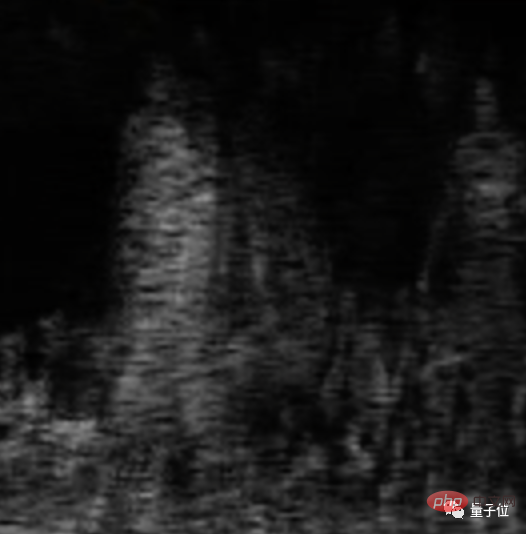
However, it is through the data contained in this "photo" that we can restore a dynamic video!
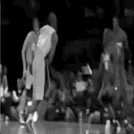
Sounds amazing, but through a method called Snapshot Compressive Imaging(Snapshot Compressive Imaging, SCI ) method can indeed be achieved.
This method can sample high-dimensional data as two-dimensional measurements, thereby achieving efficient acquisition of high-dimensional visual signals.
Take a camera as an example. Although it is a 2D sensor, if you find a way to add a digital micromirror device measurement device behind the camera lens (Digital Micromirror Devices, DMD, this It is a device that can accurately control the light source). There is a way to enable ordinary cameras to perform dimensionality reduction measurements on high-dimensional data, obtain simple 2D data, and then restore high-dimensional 3D visual signals.
For example, the frame rate of an ordinary camera is very low, and it can only take dozens of photos per second (assuming it can take 30 photos).
When we want to shoot high-speed moving objects, as long as we add this digital micromirror device to an ordinary camera, it willcompress the video signal along the time dimension. Every time we take a picture One photo can restore several or even dozens of frames of photos (that is, restore a video).
Assume that the preset compression rate for the digital micromirror device is 10. Then, taking one photo now can restore 10 photos (or a video containing 10 frames of photos) ), and the frame rate of the camera has also increased by 10 times, can take 300 photos per second.
Now the question comes, how to recover the original high-dimensional signal as efficiently as possible from these compressed low-dimensional measurement data containing noise?
With the development of deep learning, various reconstruction algorithms have been proposed. However, the accuracy and stability of reconstructed signals by these algorithms are still not good enough.
To this end, researchers from Hong Kong University, Chinese Academy of Sciences and West Lake University proposed a Deep Equilibrium Models (DEQ) method for video snapshot compression imaging , has been included in AAAI 2023:

This method not only improves the reconstruction accuracy and stability, but also further optimizes the memory footprint— —
The algorithm only requires constant-level memory during training and testing, that is: when using deep learning, the memory space it consumesdoes not change with the depth of the network (When using traditional optimization methods, the memory space consumed does not change with the number of iterations) .
Lets come look.
What is the difficulty of snapshot compression imaging?
Benefiting from the design of novel optical hardware and imaging algorithms, Snapshot Compressive Imaging (Snapshot Compressive Imaging, SCI) system can perform high-dimensional data as a two-dimensional measurement in one snapshot measurement sampling to achieve efficient acquisition of high-dimensional visual signals.
As shown in Figure 1, the SCI system can be divided into two parts, hardware encoding and software decoding:
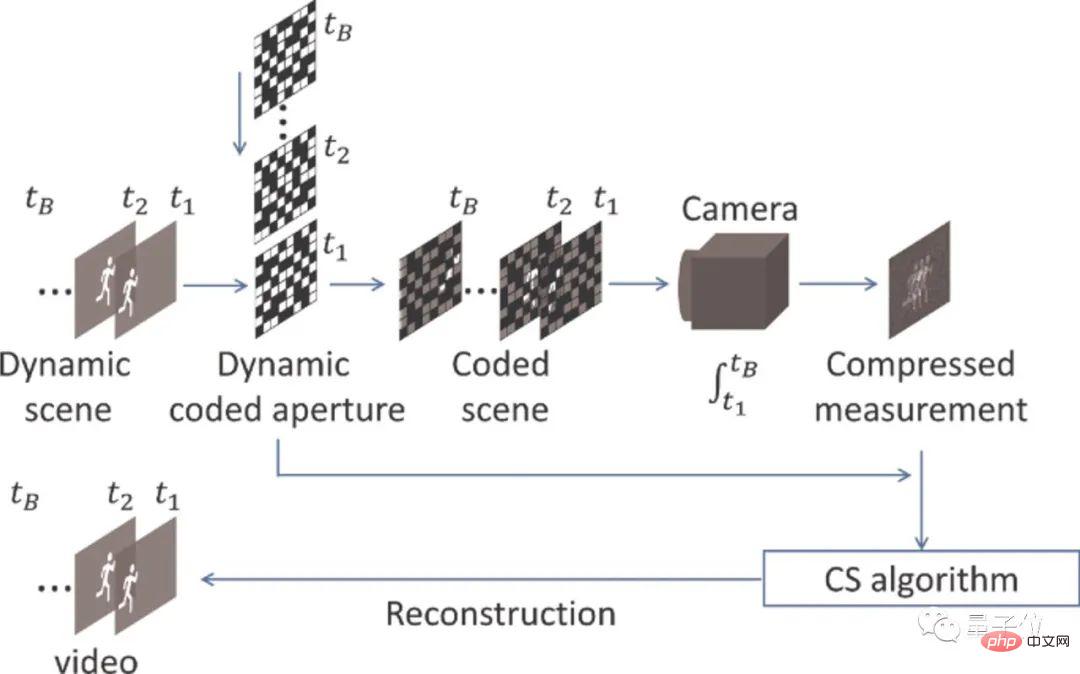
△Fig. 1. The snapshot compression imaging system uses low-dimensional sensors to capture high-dimensional data in snapshot measurements
Taking video shooting as an example, through hardware encoding, the SCI system samples the video data and compresses it in the time dimension; thereafter, Algorithms are employed to reconstruct the original high-dimensional video data.
Consider the video SCI system here, as shown in Video 1. The upper part of the video shows the compression measurements obtained by the hardware part of the SCI system, and the lower part of the video shows the video results recovered using the algorithm proposed in the paper. .
Obviously, the entire imaging process needs to solve an inverse problem: How to recover video from noisy compression measurements.
Although there are many reconstruction methods that can solve the inverse problem of SCI imaging, these methods each have their own shortcomings, as shown in Figure 2:
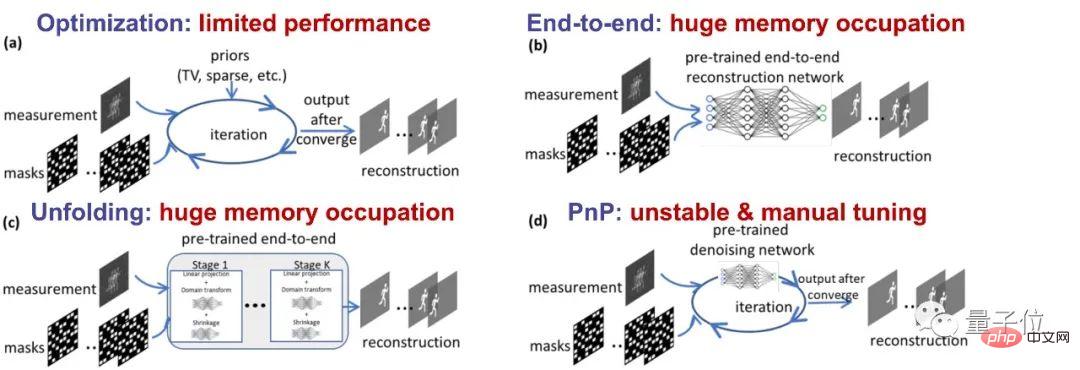
△Figure 2. Existing methods and main issues of SCI reconstruction
Among them, the traditional optimization algorithm(a)Performance limited.
With the development of deep learning, end-to-end deep networks(b)and unfolding methods(c)although they can improve performance, they inevitably Increasing layer network depth suffers from ever-increasing memory requirements and requires careful model design.
Plug and Play(PnP)Framework(d)While enjoying the advantages of data-driven regularization and flexible iterative optimization, this algorithm must be passed through appropriate Parameter settings are required to ensure accurate results, and even some complex strategies need to be adopted to obtain satisfactory performance.
Compared with other methods, the paper proposes new algorithms DE-RNN and DE-GAP to ensure the accuracy and stability of the reconstruction results. The performance of the reconstruction results can converge to A higher level, as shown in Figure 3:
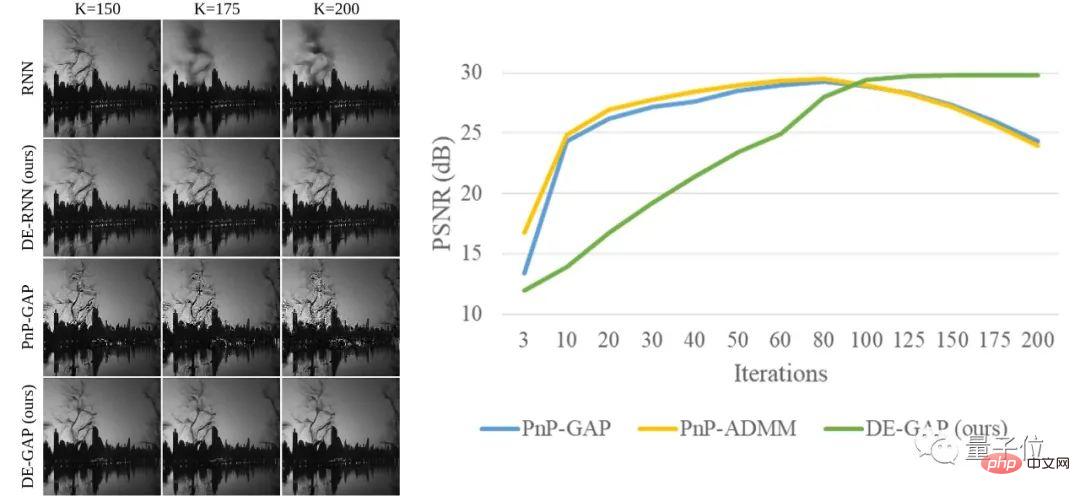
△Figure 3. Comparison of reconstruction results between DE-GAP and other methods
Generally speaking, in the past The reconstruction results of methods such as RNN and PnP are unstable, and the performance even deteriorates in long-term iterations.
However, the DE-GAP reconstruction results can maintain performance improvement as the number of iterations increases, and eventually converge to a stable result.
how did you do that?
Introducing advanced models to improve performance
In order to solve the problems of previous methods and achieve more advanced SCI reconstruction, this paper proposes a new idea for the first time——
Use DEQ model to solve the inverse problem of video SCI reconstruction.
The DEQ model was first proposed in 2019 and is mainly used in large-scale long sequence language processing tasks in natural language processing.
As shown in Figure 4, the DEQ model can directly solve for the fixed points in the process of forward propagation and back propagation through root finding methods such as Newton's iteration method, thus using only constant-level memory. Effectively implements an infinitely deep network:
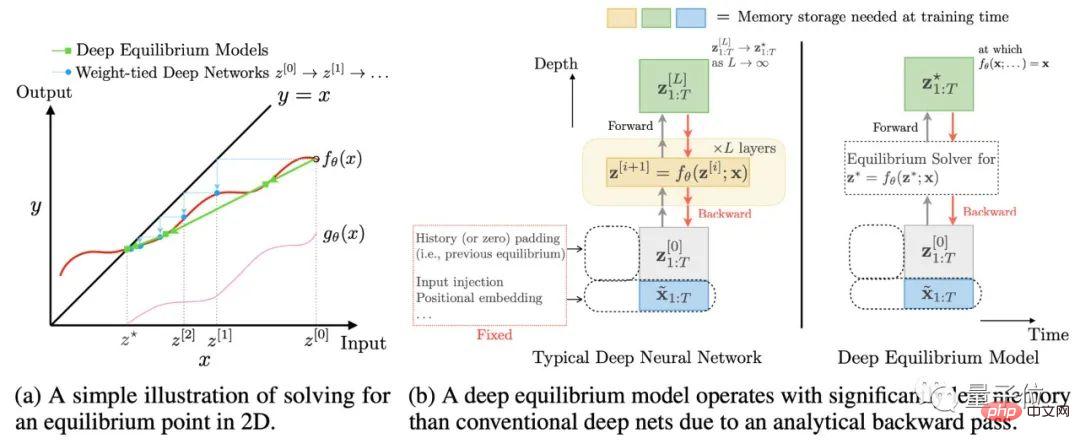
△Figure 4. Fixed point method for solving the DEQ model (left) and constant-level memory usage (right) )
(Figure 4 is from the paper: S. Bai et al, "Deep equilibrium models", NeurIPS 2019.)
Specifically, this paper will The DEQ model is applied to two existing video SCI reconstruction frameworks: RNN and PnP.
The effect is also very good. RNN is equivalent to realizing an infinitely deep network using only constant-level memory. PnP is equivalent to realizing infinitely many iterative optimization steps, and directly in the iterative optimization process. Solve for the fixed point.
As shown in Figure 5, the paper designs iterative functions combined with the DEQ model for RNN and PnP respectively, where x is the reconstruction result, y is the compression measurement, and Φ is the measurement matrix:
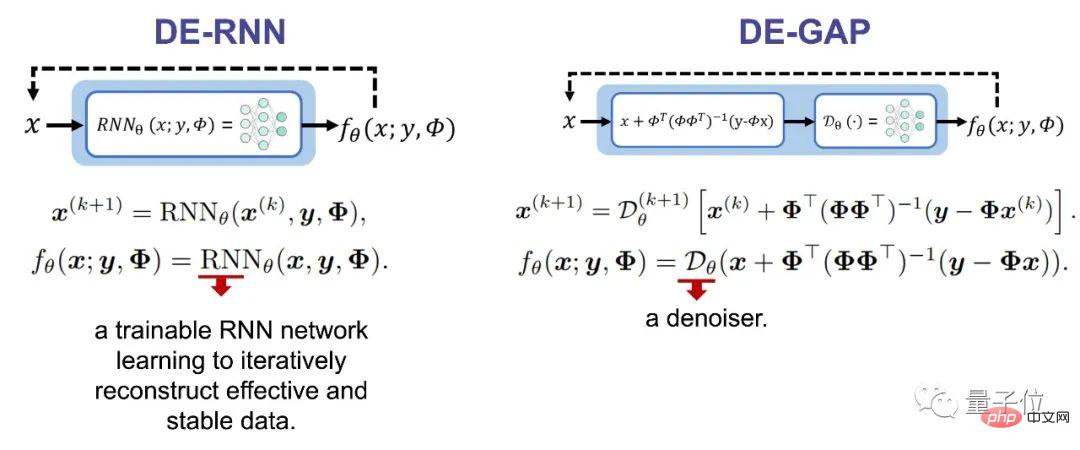
△Figure 5. The iterative functions of RNN and PnP combined with the DEQ model respectively
(For details of the specific derivation process and forward and backward propagation, please see Paper)
What are the experimental results?
The paper conducted experiments on six classic SCI data sets and real data. Compared with previous methods, the overall reconstruction results are better.
As shown in Table 1, on average, this method achieves an improvement of approximately 0.1dB in PSNR and an improvement of approximately 0.04 in SSIM. Improvements in SSIM show that this method can reconstruct images with relatively fine structures:

△Table 1. PSNR of different algorithms on six classic datasets for video SCI reconstruction (dB) and SSIM
Figure 6 is a comparison of the reconstruction results of different algorithms on classic data sets, and the presentation of some details is smoother and clearer:
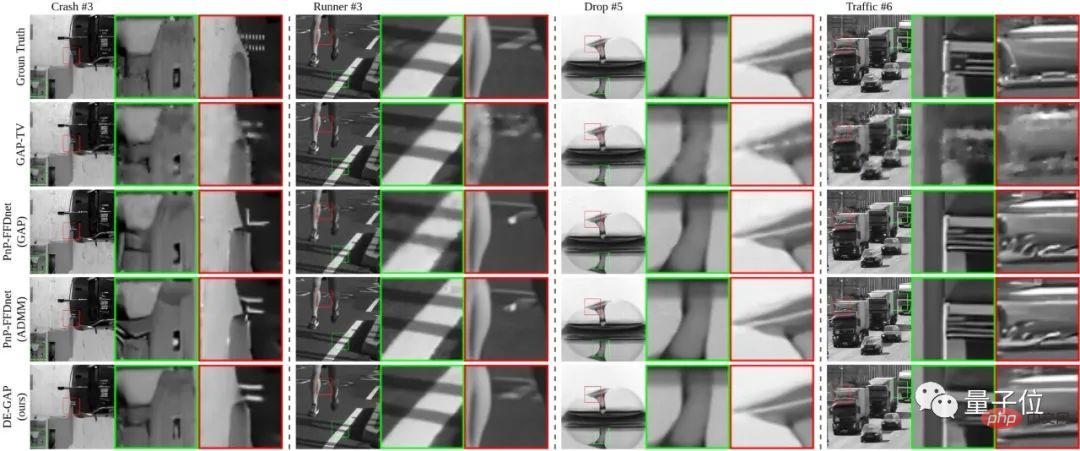
△Figure 6
Figure 7 is a comparison of the reconstruction results of different algorithms on real data, and the effect is better in comparison:
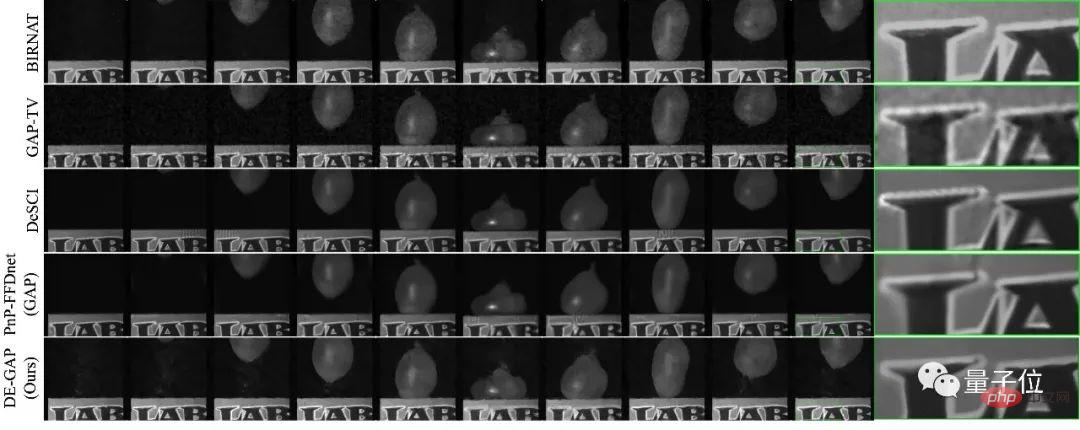
△Figure 7
More experimental results can be found in the paper.
At present, the code of the paper has been open sourced, and interested friends can use it~
(The author’s explanation video is also attached at the end of the article to explain it in simple terms)
Paper address:
https://www.php.cn/link/b8002139cdde66b87638f7f91d169d96
Code address:
##https: //www.php.cn/link/fa95123aa5f89781ed4e89a55eb2edcc
##Paper explanation video by author:
English: https://www.bilibili.com/video/BV1X54y1g7D9/
Chinese: https://www.bilibili.com/video/BV1V54y137QK/
## Plastic Cantonese: https:/ /www.bilibili.com/video/BV1224y1G7ee/
The above is the detailed content of A snapshot can restore a video! AAAI 2023 paper proposes a new algorithm for snapshot compression imaging. For more information, please follow other related articles on the PHP Chinese website!

Hot AI Tools

Undresser.AI Undress
AI-powered app for creating realistic nude photos

AI Clothes Remover
Online AI tool for removing clothes from photos.

Undress AI Tool
Undress images for free

Clothoff.io
AI clothes remover

AI Hentai Generator
Generate AI Hentai for free.

Hot Article

Hot Tools

Notepad++7.3.1
Easy-to-use and free code editor

SublimeText3 Chinese version
Chinese version, very easy to use

Zend Studio 13.0.1
Powerful PHP integrated development environment

Dreamweaver CS6
Visual web development tools

SublimeText3 Mac version
God-level code editing software (SublimeText3)

Hot Topics
 1377
1377
 52
52
 Is it infringing to post other people's videos on Douyin? How does it edit videos without infringement?
Mar 21, 2024 pm 05:57 PM
Is it infringing to post other people's videos on Douyin? How does it edit videos without infringement?
Mar 21, 2024 pm 05:57 PM
With the rise of short video platforms, Douyin has become an indispensable part of everyone's daily life. On TikTok, we can see interesting videos from all over the world. Some people like to post other people’s videos, which raises a question: Is Douyin infringing upon posting other people’s videos? This article will discuss this issue and tell you how to edit videos without infringement and how to avoid infringement issues. 1. Is it infringing upon Douyin’s posting of other people’s videos? According to the provisions of my country's Copyright Law, unauthorized use of the copyright owner's works without the permission of the copyright owner is an infringement. Therefore, posting other people’s videos on Douyin without the permission of the original author or copyright owner is an infringement. 2. How to edit a video without infringement? 1. Use of public domain or licensed content: Public
 How to remove video watermark in Wink
Feb 23, 2024 pm 07:22 PM
How to remove video watermark in Wink
Feb 23, 2024 pm 07:22 PM
How to remove watermarks from videos in Wink? There is a tool to remove watermarks from videos in winkAPP, but most friends don’t know how to remove watermarks from videos in wink. Next is the picture of how to remove watermarks from videos in Wink brought by the editor. Text tutorial, interested users come and take a look! How to remove video watermarks in Wink 1. First open wink APP and select the [Remove Watermark] function in the homepage area; 2. Then select the video you want to remove the watermark in the album; 3. Then select the video and click the upper right corner after editing the video. [√]; 4. Finally, click [One-click Print] as shown in the figure below and then click [Process].
 How to make money from posting videos on Douyin? How can a newbie make money on Douyin?
Mar 21, 2024 pm 08:17 PM
How to make money from posting videos on Douyin? How can a newbie make money on Douyin?
Mar 21, 2024 pm 08:17 PM
Douyin, the national short video platform, not only allows us to enjoy a variety of interesting and novel short videos in our free time, but also gives us a stage to show ourselves and realize our values. So, how to make money by posting videos on Douyin? This article will answer this question in detail and help you make more money on TikTok. 1. How to make money from posting videos on Douyin? After posting a video and gaining a certain amount of views on Douyin, you will have the opportunity to participate in the advertising sharing plan. This income method is one of the most familiar to Douyin users and is also the main source of income for many creators. Douyin decides whether to provide advertising sharing opportunities based on various factors such as account weight, video content, and audience feedback. The TikTok platform allows viewers to support their favorite creators by sending gifts,
 2 Ways to Remove Slow Motion from Videos on iPhone
Mar 04, 2024 am 10:46 AM
2 Ways to Remove Slow Motion from Videos on iPhone
Mar 04, 2024 am 10:46 AM
On iOS devices, the Camera app allows you to shoot slow-motion video, or even 240 frames per second if you have the latest iPhone. This capability allows you to capture high-speed action in rich detail. But sometimes, you may want to play slow-motion videos at normal speed so you can better appreciate the details and action in the video. In this article, we will explain all the methods to remove slow motion from existing videos on iPhone. How to Remove Slow Motion from Videos on iPhone [2 Methods] You can use Photos App or iMovie App to remove slow motion from videos on your device. Method 1: Open on iPhone using Photos app
 How to post videos on Weibo without compressing the image quality_How to post videos on Weibo without compressing the image quality
Mar 30, 2024 pm 12:26 PM
How to post videos on Weibo without compressing the image quality_How to post videos on Weibo without compressing the image quality
Mar 30, 2024 pm 12:26 PM
1. First open Weibo on your mobile phone and click [Me] in the lower right corner (as shown in the picture). 2. Then click [Gear] in the upper right corner to open settings (as shown in the picture). 3. Then find and open [General Settings] (as shown in the picture). 4. Then enter the [Video Follow] option (as shown in the picture). 5. Then open the [Video Upload Resolution] setting (as shown in the picture). 6. Finally, select [Original Image Quality] to avoid compression (as shown in the picture).
 How to publish Xiaohongshu video works? What should I pay attention to when posting videos?
Mar 23, 2024 pm 08:50 PM
How to publish Xiaohongshu video works? What should I pay attention to when posting videos?
Mar 23, 2024 pm 08:50 PM
With the rise of short video platforms, Xiaohongshu has become a platform for many people to share their lives, express themselves, and gain traffic. On this platform, publishing video works is a very popular way of interaction. So, how to publish Xiaohongshu video works? 1. How to publish Xiaohongshu video works? First, make sure you have a video content ready to share. You can use your mobile phone or other camera equipment to shoot, but you need to pay attention to the image quality and sound clarity. 2. Edit the video: In order to make the work more attractive, you can edit the video. You can use professional video editing software, such as Douyin, Kuaishou, etc., to add filters, music, subtitles and other elements. 3. Choose a cover: The cover is the key to attracting users to click. Choose a clear and interesting picture as the cover to attract users to click on it.
 How to convert videos downloaded by uc browser into local videos
Feb 29, 2024 pm 10:19 PM
How to convert videos downloaded by uc browser into local videos
Feb 29, 2024 pm 10:19 PM
How to turn videos downloaded by UC browser into local videos? Many mobile phone users like to use UC Browser. They can not only browse the web, but also watch various videos and TV programs online, and download their favorite videos to their mobile phones. Actually, we can convert downloaded videos to local videos, but many people don't know how to do it. Therefore, the editor specially brings you a method to convert the videos cached by UC browser into local videos. I hope it can help you. Method to convert uc browser cached videos to local videos 1. Open uc browser and click the "Menu" option. 2. Click "Download/Video". 3. Click "Cached Video". 4. Long press any video, when the options pop up, click "Open Directory". 5. Check the ones you want to download
 7-zip maximum compression rate setting, how to compress 7zip to the minimum
Jun 18, 2024 pm 06:12 PM
7-zip maximum compression rate setting, how to compress 7zip to the minimum
Jun 18, 2024 pm 06:12 PM
I found that the compressed package downloaded from a download website will be larger than the original compressed package after decompression. The difference is tens of Kb for a small one and several dozen Mb for a large one. If it is uploaded to a cloud disk or paid space, it does not matter if the file is small. , if there are many files, the storage cost will be greatly increased. I studied it specifically and can learn from it if necessary. Compression level: 9-Extreme compression Dictionary size: 256 or 384, the more compressed the dictionary, the slower it is. The compression rate difference is larger before 256MB, and there is no difference in compression rate after 384MB. Word size: maximum 273 Parameters: f=BCJ2, test and add parameter compression rate will be higher



